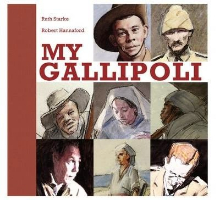‘No one will leave his place until our enemy is driven back into the sea’, says Josef Demir of the 9th Division of the Turkish 5th Army, of his Gallipoli. This campaign lasted eight months during World War I, beginning in April 1915, and there are many picture books which immortalise it. Ruth Starke’s approach is to acknowledge that it was not just Australian and New Zealanders who were involved in the action.
One century on, Starke brings back to life the soldiers of many nations including an Aboriginal serviceman who was not regarded as a citizen of his own country. She has used the voices of individual contemporary accounts – journalists, letter writers and diarists who recorded the action - so that the reader of today can piece together what happened. (The chronological account begins with the voice of a fictitious Turkish shepherd.) Her use of the repeated phrase ‘This is my Gallipoli’ underlines that truth can be told through a variety of voices. A solitary mourner in our own time ends the book. There is a bibliography and biographical information appended to encourage further reading, and the map at the start will help place the action with both English and Turkish place names given.
This story begins on a peninsula’s soft grassland and ends with the emerald of a well-manicured cemetery. Robert Hannaford has employed the greys and khakis of battle with gold and saffron accents in watercolour and gouache. He has chosen charcoal as the ideal medium to portray battle action - moments which accumulated into a hard scrabble campaign with over 130,000 dead. Australian deaths were about 10% of those of Ottoman soldiers.
The cover of the book resembles a photograph album – often the only relic within a family of a young life lost prematurely in battle.

